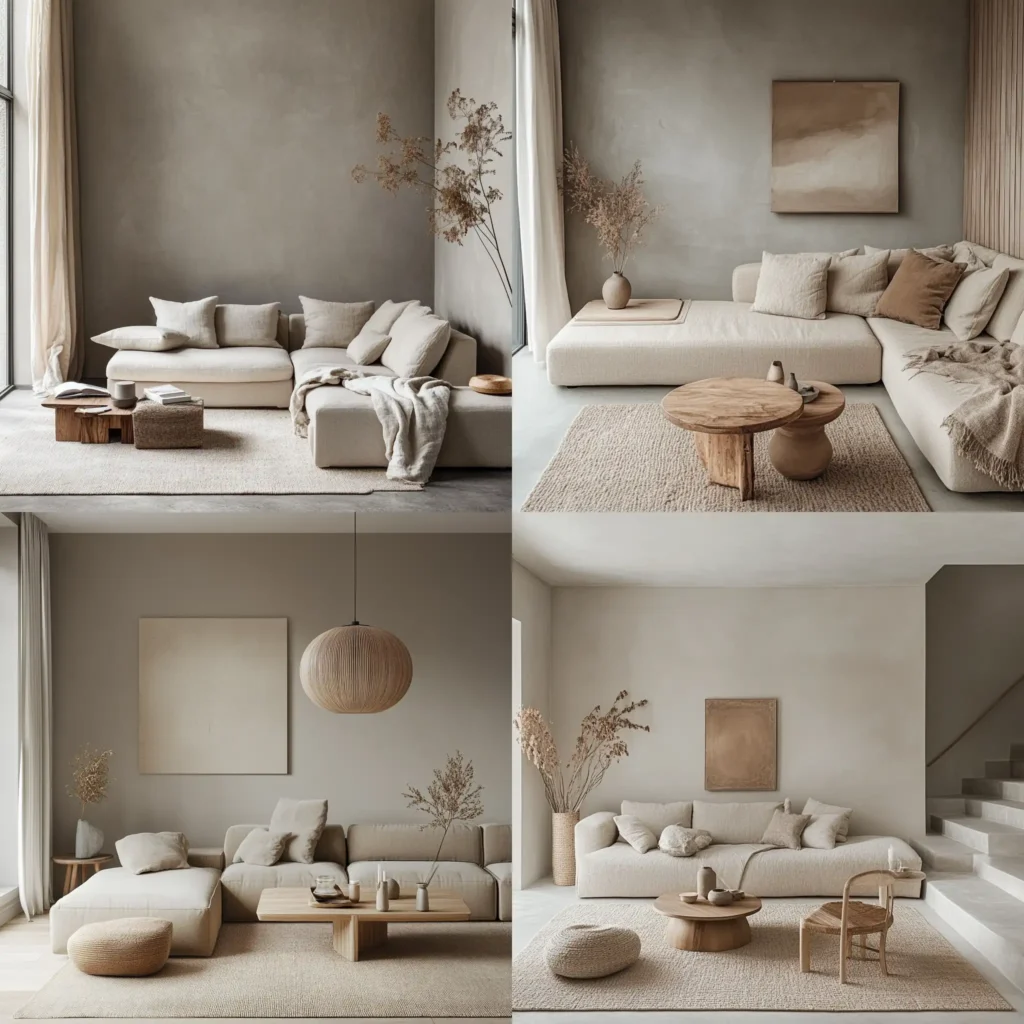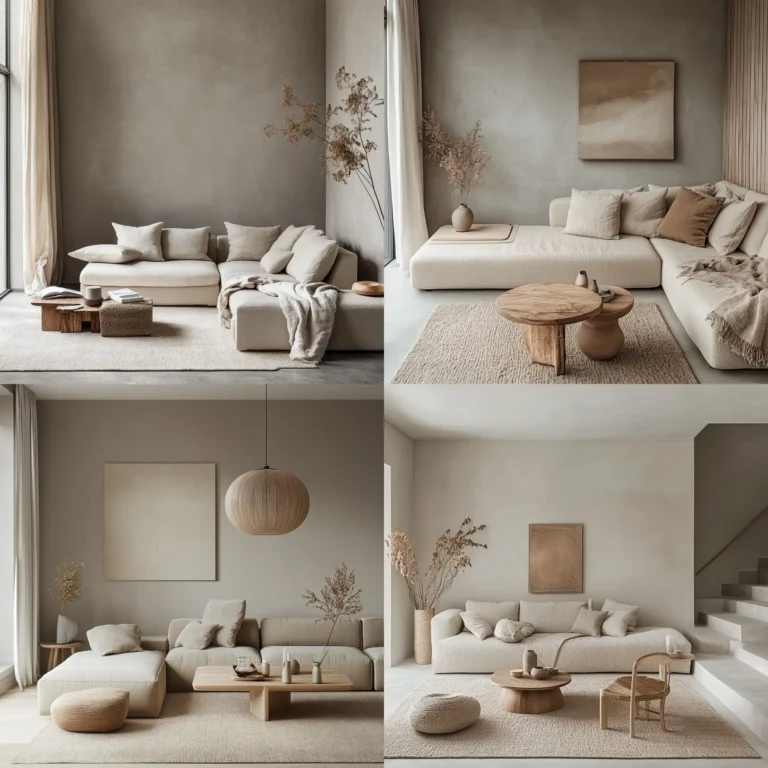The Japandi living room combines the clean lines and functionality of Scandinavian design with the warmth and simplicity of Japanese aesthetics. This fusion creates a serene and peaceful environment, perfect for relaxation and unwinding. Whether you’re looking to redesign your living room or just want to add a few elements of Japandi style, these 13 ideas will help you create a tranquil, minimalist space.
Table of Contents
1. Embrace Neutral Tones
In a Japandi living room, neutral tones are key. Think shades of beige, soft greys, and whites that help create a calm, soothing atmosphere. These colors set the foundation for a minimalist yet welcoming space.
Opt for a light-colored sofa or neutral-toned rugs, and balance the colors with natural wood accents and plants to add warmth and texture to the room.

2. Focus on Functionality
One of the main principles of Japandi living room design is functionality. Every piece of furniture should serve a purpose. Choose furniture that is both stylish and functional, such as storage ottomans or low-profile coffee tables that can double as seating.
Incorporate hidden storage solutions to keep the space uncluttered and organized. The goal is to create a room where everything has its place and nothing is unnecessary.
3. Mix Japanese and Scandinavian Elements
The beauty of Japandi living room design lies in its blend of two different cultural styles. Scandinavian furniture tends to be sleek and functional, while Japanese design focuses on simplicity and natural materials.
Choose pieces that embody both styles, such as a wooden coffee table with clean lines and a low, comfortable sofa. Add Japanese-inspired elements like tatami mats or shoji screens to create a balanced and harmonious look.
4. Add Natural Materials
Wood is a dominant material in Japandi living room design. Incorporate it through furniture, flooring, or even wall panels. Wood adds warmth to the space, creating an inviting and earthy ambiance.
Pair wooden furniture with other natural materials like bamboo, linen, or stone for an authentic, grounded feel. These elements also bring a sense of nature into the room, which is central to Japandi style.
5. Keep the Space Minimalist
Minimalism is at the heart of Japandi living room design. The goal is to create a clutter-free environment where each item has a purpose. Avoid overcrowding the space with too many decorative objects or furniture pieces.
Instead, choose a few carefully selected items that bring joy and add functionality to the room. Keep surfaces clean and open, with minimal decoration to maintain a serene, spacious feel.
6. Add Greenery
Plants are an important part of Japandi living room design, as they bring a sense of tranquility and life to the space. Incorporate indoor plants like bonsai trees, ferns, or succulents to add a touch of nature.
Place plants in simple, earthy pots or baskets to complement the minimalist aesthetic. Greenery helps balance the neutral tones and adds a calming atmosphere to your living room.
For more tips on room-specific decor, visit our Room-Specific Decor guide.
7. Use Soft Lighting
Soft, ambient lighting is essential in a Japandi living room to create a relaxing and cozy environment. Use low-wattage bulbs, pendant lights, or paper lanterns to add a soft, warm glow to the space.
Consider using dimmable lights or adding floor lamps to provide flexible lighting that can be adjusted based on the time of day or mood you’re trying to set.
8. Incorporate Wabi-Sabi Aesthetics
Wabi-sabi, a Japanese philosophy that celebrates imperfection, is a key element of Japandi living room design. This aesthetic emphasizes the beauty of simple, natural objects that show signs of age or wear.
Incorporate wabi-sabi into your living room with handmade pottery, weathered wood furniture, or textiles with a lived-in feel. These elements add character and authenticity to the space.
9. Create a Zen-Inspired Corner
A Japandi living room is all about creating a space that promotes relaxation and mindfulness. Dedicate a corner of your room to a zen-inspired setup, such as a meditation cushion or a low-profile floor chair.
Add a small fountain or a bonsai tree to enhance the calm, peaceful vibe of the space. This area can serve as a sanctuary for relaxation, reading, or meditation.
10. Use Textiles for Comfort
While Japandi living room design is minimalist, it doesn’t mean sacrificing comfort. Incorporate soft, natural textiles like linen or wool for throw pillows, blankets, and cushions.
These textiles not only add warmth to the space but also enhance the sensory experience of your living room, making it a place you’ll want to relax in for hours.
11. Play with Symmetry
Symmetry is an important concept in Japandi living room design. It promotes balance and harmony, which are key principles of this style. Arrange furniture and decor in a way that creates a sense of equilibrium.
For example, place two identical armchairs across from a sofa, or use matching side tables on either side of a couch. This simple yet effective design trick helps create a sense of peace and order.
12. Keep It Simple with Art
Art in a Japandi living room should be simple and understated. Opt for minimalist pieces that complement the overall design without overwhelming the space.
Black and white photography, abstract art, or simple line drawings work well in Japandi interiors. Choose frames that are simple and unobtrusive, such as thin wood frames or no frames at all.
13. Make the Most of Small Spaces
If you’re working with a small living room, Japandi living room design is perfect. The minimalist approach creates the illusion of more space, and functional furniture ensures that every inch is used effectively.
Opt for low-profile furniture that doesn’t dominate the room and use light, neutral colors to make the space feel open and airy.
FAQs About Japandi Living Rooms
Q1: What is the difference between Japandi and Scandinavian design?
A1: Japandi combines the simplicity and natural elements of Japanese design with the functional, minimalist style of Scandinavian interiors. The result is a warm, inviting, and functional space.
Q2: How can I incorporate Japandi style into a small living room?
A2: Use light, neutral colors, low-profile furniture, and minimalist decor to create a sense of openness. Incorporate natural materials and greenery to add warmth and texture.
Q3: Can I mix Japandi with other design styles?
A3: Yes, Japandi style is versatile and can be mixed with other minimalist or nature-inspired designs. Just be sure to maintain balance and simplicity.
Q4: How do I make my Japandi living room more comfortable?
A4: Add soft textiles, such as throw blankets and cushions, and use ambient lighting to create a cozy atmosphere. Incorporate plants and natural materials to enhance the comfort and warmth of the space.
Final Thoughts
Creating a Japandi living room is all about balancing simplicity, functionality, and natural beauty. By incorporating these 13 ideas, you can transform your living space into a peaceful retreat that promotes relaxation and mindfulness. Whether you’re redesigning an entire room or just adding a few key pieces, the Japandi style can make any living room feel serene, welcoming, and stylish.

